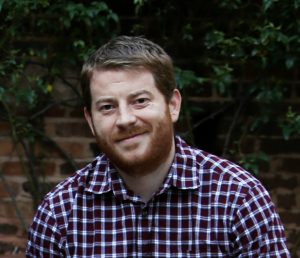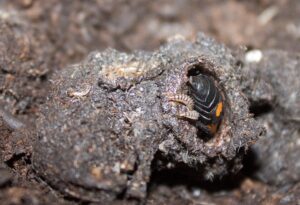
About the Author: Dr. Christopher Cunningham is a Senior Research Associate in the Department of Entomology at the University of Georgia. Chris is interested in the understanding the genomic mechanisms that underpin behavior.
Every animal has to respond to environmental changes. This is true of their social environment as any other, which can be especially challenging because it contains an interactive partner. This means that behavioral changes need to be flexible and rapid. This has led some to suggest that behavioral evolution is special; however, behavioral evolution obeys all known rules of evolution once the interacting partner is taken into account (Bailey et al., 2018). Historically, studies of behavior and its genetic underpinnings have focused on single genes. With the accessibility of Next Generation Sequencing, understanding how animals regulate and change their behavior can now be answered genome-wide.
This is where I entered the field and began to study a burying beetle that has elaborate parental care, Nicrophorus vespilloides. This species will find a vertebrate carcass, bury it (hence the name of the group), prevent it from rotting, and females (and sometimes males) will directly feed larvae processed food once they arrive. Interestingly, males, when their female partner is removed, will many times take over direct feeding of larvae. After many years and against the backdrop of many failed attempts for each, we finally made the species tractable to genomics, RNA-sequencing, qRT-PCR, and proteomics (much of this was done while I was a Post-Doctoral Research Associate with Prof. Allen Moore in the Department of Genetics at the University of Georgia). So, we now had the ability to assay what genes change after a change of social environment for a complex behavior while knowing exactly when that change took place. All of that research and methods development led a 2019 paper, where I and others showed that differential gene expression of male parental care is associated with difference of behavioral states, not with differences of behavioral flexibility (i.e., whether or not a male changed his behavior after his partner was removed), and that changes of cytosine methylation were not associated with this behavioral change or with gene expression changes (Cunningham et al., 2019). However, I was still interested in better understanding what genomic mechanisms allowed behavioral changes and why some individuals did change their behavior while others did not.

This research motivated further questions of what was responsible for gene expression changes between behavioral states in response to a change of social environment. After cytosine methylation we decided to profile histone tail post-translational modifications (PTMs). The first mark we decided to profile was tri-methylation of lysine four of histone three (H3K4me3) using chromatin immunoprecipitation followed by sequencing (ChIP-seq). It is a histone PTM associated with the proximal promoter of expressed genes and one that we thought would have a strong association with genes that change their expression between two different social environments. For this project I was awarded an AGA Evolutionary, Ecological, and Conservation Genomics (EECG) Research Award.
Now, we get into the real-life part. Or as one might put it – this is how my research plans did not come to fruition in the timeframe that I wanted. In the time between the award and now, I have made two international moves (the samples had to make one with me). One move involved setting up and kitting a research space capable of doing the molecular genetics and genomics that I wanted to do for this and other projects. After each move, my research focused on establishing myself as a new member of an established community. This meant time devoted to new projects, collaborations, and grants for those new ideas that took me away from old projects. Integrating with new colleagues and institutions is a necessary part of global scientific life. None of that is badper se, but I find something that is often not talked about with all that openly is – What is the value of leaving old project that are partially finished to achieve clear independence of previous research groups? I have no great answers to that question. But this project has caused me to reflect on my own choices. I generally prioritized new projects over older projects that were closer to publication. Having my time split between new projects and older, follow-on projects has been the greatest challenge to this research.
Where does my EECG project stand? The project is currently incomplete. It is however to a stage where I have spoken about it at invited seminars and conferences. I struggled with myself about whether to even speak about this project in those talks. It is an overall negative result of one measure, which gives an incomplete understanding and is something that pushes for highly stringent validation of results. In the end, I decided that I would talk about it as it is another piece of my personal scientific puzzle and I wanted people to know about it. This has produced an interesting personal observation over the last few years about the soft value of negative results. Of all of the projects and results that I have talked about, it is just as likely that I will speak with someone after a talk about the negative result as some of my other positive results. That is something that took me by surprise. Many people seem to have those projects that produced negative results and they are still working on how to validate that result. This is something that I knew and expected, but what I did not expect was the “bonding” this might produce among two or more people that never meet before. Nothing concrete or grandiose has come from any of these conversations, but it has likely allowed me to meet more people than if I only spoke about the part of my science that was working and produced robust, positive results. Perhaps it made my research more approachable to people and allowed them to have something to more easily to interact with about my research.
In the end has this project been a success? In a word, no. Has this project been a failure? Also, no. I have found that I learn a great deal from hard projects. I rarely offer direct advice and I will not here either. I can, however, say that I will limit the number of projects I engage with moving forward to ensure I get all my projects done. I have learned that one finished project is worth many, many unfinished ones. Perhaps, I should have titled the post as the value of learning to saying no.
References



